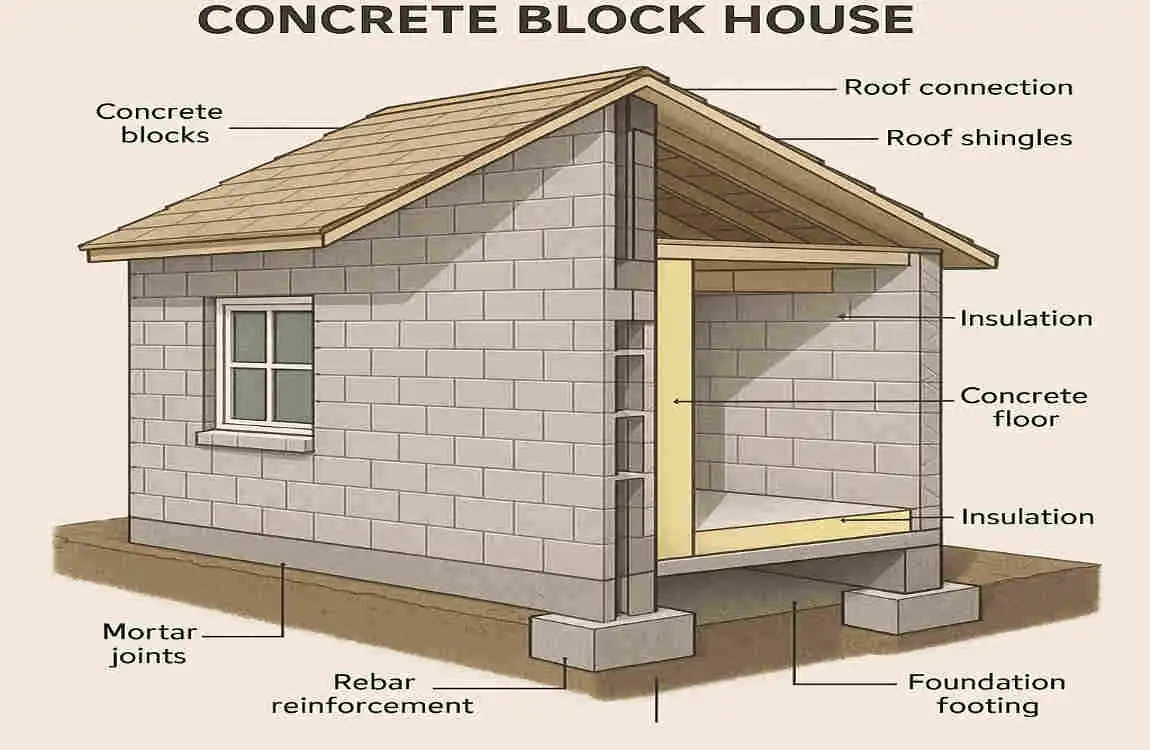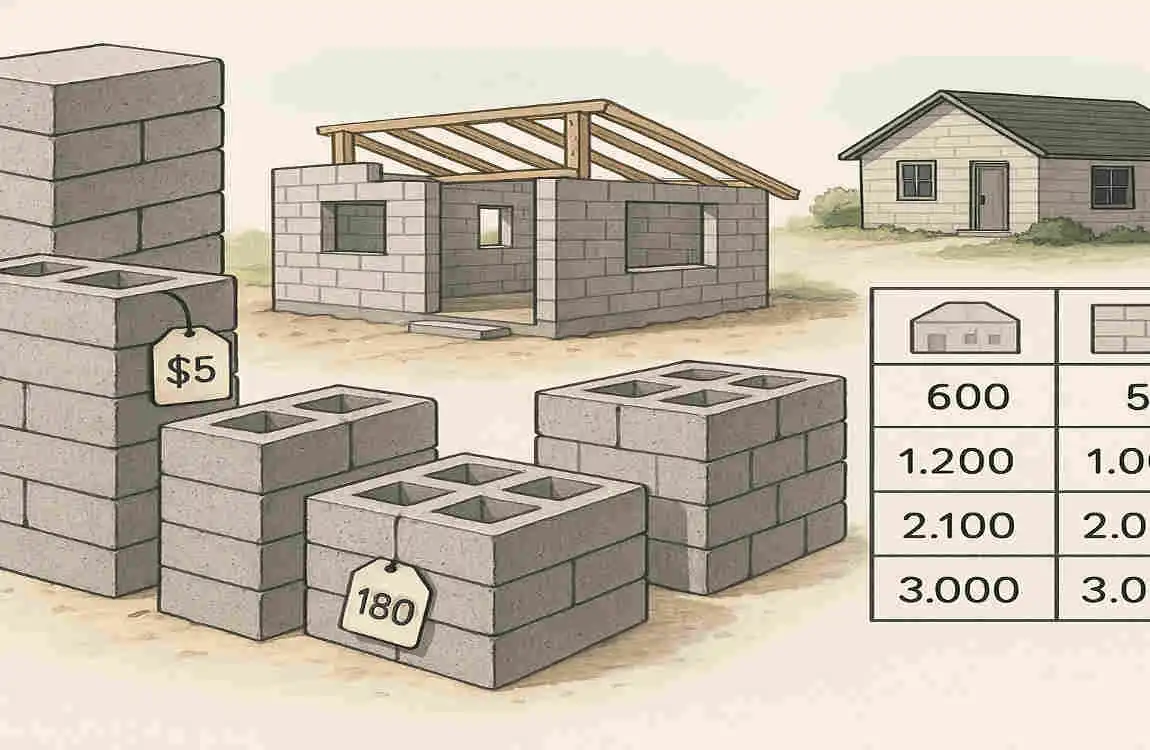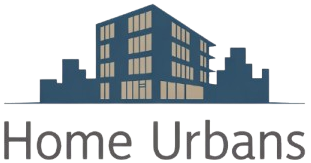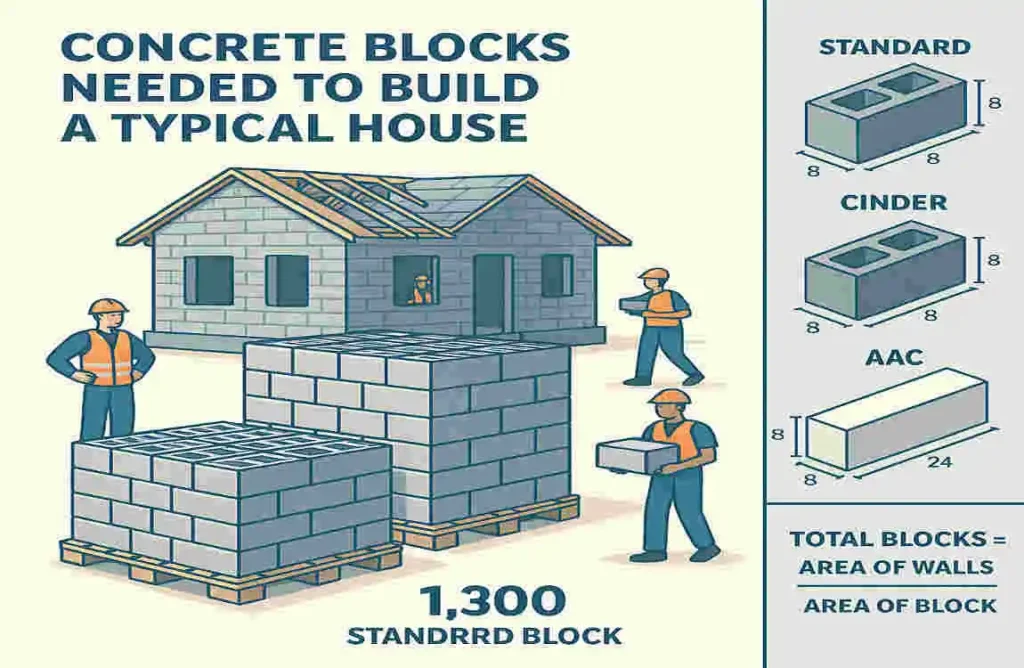Building a house from scratch is an exciting journey, but it can also be overwhelming with all the decisions you need to make. One crucial aspect to consider early on is the number of concrete blocks needed for your project.
Understanding Concrete Block Houses

What is a Concrete Block House?
A concrete block house is precisely what it sounds like – a home constructed using concrete blocks as the primary building material. These blocks, also known as concrete masonry units (CMUs), are made from a mixture of cement, sand, and aggregate, and are available in various sizes and shapes.
Advantages of Using Concrete Blocks for Building Homes
There are several reasons why concrete blocks are a popular choice for home construction:
- Durability: Concrete blocks are known for their strength and longevity, making them an excellent choice for building a sturdy and long-lasting home.
- Fire Resistance: Concrete blocks have a high fire resistance rating, providing an added layer of safety for your family.
- Energy Efficiency: Concrete blocks have excellent thermal mass, helping regulate indoor temperatures and reduce energy costs.
- Cost-Effectiveness: While the initial cost of concrete blocks may be higher than other materials, they can save you money in the long run due to their durability and energy efficiency.
Types of Concrete Blocks Commonly Used in House Construction
When it comes to building a concrete block house, you’ll have several types of blocks to choose from:
- Standard Concrete Blocks: The most common type of block used in residential construction. They come in various sizes, typically 8 x 8 x 16 inches.
- Lightweight Concrete Blocks: These blocks are made with lightweight aggregates, making them easier to handle and transport. They are often used for non-load-bearing walls.
- Hollow Concrete Blocks: These blocks have hollow cores, which can be filled with concrete or insulation to increase their strength and energy efficiency.
- Solid Concrete Blocks: These blocks are solid throughout and are typically used for load-bearing walls or foundations.
Standard Sizes of Concrete Blocks and Their Impact on Quantity Estimates
The size of the concrete blocks you choose will directly affect the number of blocks needed for your project. The most common size for residential construction is 8 x 8 x 16 inches, but blocks are also available in other sizes, such as 4 x 8 x 16 inches or 12 x 8 x 16 inches.
When estimating the number of blocks required, keep in mind that larger blocks will cover more area than smaller blocks, but they may also be more challenging to handle and require specialised equipment for installation.
Factors Influencing the Number of Concrete Blocks Needed
Several factors will influence the number of concrete blocks needed to build your house. Let’s take a closer look at each one:
Size and Design of the House
The size and design of your house will have the most significant impact on the number of concrete blocks required. A larger house with more square footage and multiple stories will naturally require more blocks than a smaller, single-story home.
Wall Thickness and Height
The thickness and height of your walls will also affect the number of blocks needed. Thicker walls will require more blocks per square foot, while taller walls will require more blocks overall.
Size of Doors and Windows
The size and number of doors and windows in your house will reduce the number of blocks needed, as these openings do not require blocks. Make sure to account for these openings when estimating your block count.
Type of Concrete Block Used
As we mentioned earlier, the type of concrete block you choose will impact the number of blocks required. Lightweight blocks may cover less area per block than standard blocks, while hollow blocks may require less material overall but more blocks to achieve the same strength.
Construction Method and Mortar Thickness
The construction method and mortar thickness will also affect the number of blocks needed. Some construction methods, such as running bond, may require more blocks than others. Additionally, thicker mortar joints will reduce the number of blocks required per square foot.
Step-by-Step Formula to Estimate Concrete Blocks Required
Now that we’ve covered the factors that influence the number of concrete blocks needed, let’s walk through a step-by-step formula to help you estimate the number of blocks required for your project.
Description of the Basic Formula
The basic formula for estimating the number of concrete blocks required is as follows:
- Calculate the total wall area: multiply each wall’s length by its height, then add the areas of all the walls.
- Subtract the area of openings: Subtract the area of doors and windows from the total wall area.
- Determine the block size and coverage area per block: Choose the concrete block size you’ll use and calculate its coverage area (length x height).
- Divide the net wall area by the block coverage: Divide the total wall area minus the area of openings by the coverage area per block to get the estimated number of blocks needed.
Example Calculation with Realistic House Dimensions
Let’s walk through an example calculation using realistic house dimensions to help you better understand the formula.
Suppose you’re building a single-story house with the following dimensions:
- Length: 50 feet
- Width: 30 feet
- Wall height: 8 feet
- Door size: 3 feet x 7 feet (2 doors)
- Window size: 3 feet x 4 feet (4 windows)
- Concrete block size: 8 x 8 x 16 inches
First, let’s calculate the total wall area:
- Front and back walls: 50 feet x 8 feet = 400 square feet each
- Side walls: 30 feet x 8 feet = 240 square feet each
- Total wall area: 400 + 400 + 240 + 240 = 1280 square feet
Next, let’s subtract the area of the openings:
- Doors: 3 feet x 7 feet x 2 = 42 square feet
- Windows: 3 feet x 4 feet x 4 = 48 square feet
- Total opening area: 42 + 48 = 90 square feet
- Net wall area: 1280 – 90 = 1190 square feet
Now, let’s determine the block size and coverage area per block:
- Block size: 8 x 8 x 16 inches = 0.67 x 0.67 x 1.33 feet
- Coverage area per block: 0.67 x 0.67 = 0.45 square feet
Finally, let’s divide the net wall area by the block coverage to get the estimated number of blocks needed:
- Estimated number of blocks: 1190 / 0.45 = 2644 blocks
So, for this example house, you would need approximately 2644 concrete blocks to complete the project.
Quick Estimation Table for Common House Sizes

To help you quickly estimate the number of concrete blocks needed for your project, we’ve put together a handy table with approximate block numbers for standard house sizes. Keep in mind that these are rough estimates and may vary depending on the factors we discussed earlier.
House Size (Square Feet)Single-Story Block Count Two-Story Block Count
1000 2000-2500 4000-5000
1500 3000-3750 6000-7500
2000 4000-5000 8000-10000
When using this table for fast estimates, keep the following tips in mind:
- Use the lower end of the range for smaller houses with fewer openings and thinner walls.
- Use the higher end of the range for larger houses with more openings and thicker walls.
- Always round up to the nearest hundred to account for waste and breakage.
Additional Considerations When Ordering Blocks
When ordering concrete blocks for your project, there are a few additional considerations to keep in mind:
Ordering Extra Blocks for Wastage and Breakage
It’s always a good idea to order extra blocks to account for waste and breakage during construction. A general rule of thumb is to order 5-10% more blocks than your estimated count to ensure you have enough to complete the project.
Supplier Packaging and Block Availability
When ordering blocks, make sure to check with your supplier about their packaging and availability. Some suppliers may only sell blocks in full pallets or truckloads, so you’ll need to factor this into your order.
Delivery and Storage Tips to Maintain Block Quality
To maintain the quality of your concrete blocks, make sure to follow these delivery and storage tips:
- Have the blocks delivered as close to the construction site as possible to minimise handling.
- Store the blocks on a flat, dry surface, protected from the elements.
- Stack the blocks no more than 6 feet high to prevent crushing or damage.
Cost Estimation Based on Block Quantity
Now that you have an estimate of the number of concrete blocks needed for your project, let’s talk about how to estimate the cost.
Average Price per Concrete Block by Region
The average price per concrete block can vary by region and block type. Here are some rough estimates of the average price per block in the different areas:
- Northeast: $1.50-$2.50 per block
- Southeast: $1.25-$2.00 per block
- Midwest: $1.00-$1.75 per block
- Southwest: $1.25-$2.00 per block
- West: $1.50-$2.50 per block
Keep in mind that these are rough estimates and may vary depending on your specific location and supplier.
How to Calculate Approximate Material Cost from Block Count
To calculate the approximate material cost from your block count, multiply the number of blocks needed by the average price per block in your region. For example, if you need 2644 blocks and the average price per block in your region is $1.75, your estimated material cost would be:
2644 blocks x $1.75 per block = $4,627
Factors Affecting Cost
Keep in mind that the total cost of your project will be affected by several factors, including:
- Block Type: The type of concrete block you choose will impact the cost. Lightweight blocks may be more expensive than standard blocks, while hollow blocks may be less expensive but require more material to achieve the same strength.
- Mortar: The cost of mortar must also be factored into your total project cost. The amount of mortar required will depend on the size of your blocks and the thickness of your mortar joints.
- Labour: Labour costs will vary by location and project complexity. Make sure to get quotes from multiple contractors to ensure you’re getting the best price.

